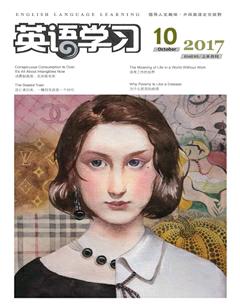消費新趨勢:無形勝有形
By+Elizabeth+Currid-Halkett



In 1899, the economist Thorstein Veblen2 observed that silver spoons and corsets were markers of elite social position. He coined the phrase “conspicuous consumption” to denote the way that material objects were paraded3 as indicators of social position and status. More than 100 years later, conspicuous consumption is still part of the contemporary capitalist landscape, and yet today, luxury goods are significantly more accessible than in Veblens time. This deluge4 of accessible luxury is a function of the massproduction economy of the 20th century, the outsourcing of production to China, and the cultivation of emerging markets where labour and materials are cheap. At the same time, weve seen the arrival of a middle-class consumer market that demands more material goods at cheaper price points.
However, the democratisation of consumer goods has made them far less useful as a means of displaying status. In the face of rising social inequality, both the rich and the middle classes own fancy TVs and nice handbags. They both lease SUVs, take airplanes, and go on cruises. On the surface, the ostensible5 consumer objects favoured by these two groups no longer reside in two completely different universes.
Given that everyone can now buy designer handbags and new cars, the rich have taken to using much more tacit signifiers of their social position. Yes, oligarchs6 and the superrich still show off their wealth with yachts and Bentleys and gated mansions. But the dramatic changes in elite spending are driven by a well-to-do, educated elite, or what I call the “aspirational class”. This new elite cements its status through prizing knowledge and building cultural capital, not to mention the spending habits that go with it—preferring to spend on services, education and human-capital investments over purely material goods. These new status behaviours are what I call “inconspicuous consumption”.
The rise of the aspirational class and its consumer habits is perhaps most salient7 in the United States. The US Consumer Expenditure Survey data reveals that, since 2007, the countrys top 1 per cent (people earning upwards of $300,000 per year) are spending significantly less on material goods, while middle-income groups (earning approximately $70,000 per year) are spending the same, and their trend is upward. Eschewing8 an overt materialism, the rich are investing significantly more in education, retirement and health—all of which are immaterial, yet cost many times more than any handbag a middle-income consumer might buy.endprint
The vast chasm9 between middle-income and top 1 per cent spending on education in the US is particularly concerning because, unlike material goods, education has become more and more expensive in recent decades. Thus, there is a greater need to devote financial resources to education to be able to afford it at all. According to Consumer Expenditure Survey data from 2003—2013, the price of college tuition increased 80 per cent, while the cost of womens apparel10 increased by just 6 per cent over the same period.
While much inconspicuous consumption is extremely expensive, it shows itself through less expensive but equally pronounced signaling—from reading The Economist to buying pasture-raised eggs. Inconspicuous consumption in other words, has become a shorthand11 through which the new elite signal their cultural capital to one another. In lockstep with the invoice for private preschool comes the knowledge that one should pack the lunchbox with quinoa crackers and organic fruit.12 One might think these culinary13 practices are a commonplace example of modern-day motherhood, but one only needs to step outside the upper-middleclass bubbles of the coastal cities of the US to observe very different lunch-bag norms, consisting of processed snacks and practically no fruit.
Knowing these seemingly inexpensive social norms is itself a rite of passage14 into todays aspirational class. And that rite is far from costless: The Economist subscription might set one back only $100, but the awareness to subscribe and be seen with it tucked in ones bag is likely the iterative result of spending time in elite social milieus and expensive educational institutions that prize this publication and discuss its contents.15
Perhaps most importantly, the new investment in inconspicuous consumption reproduces privilege in a way that previous conspicuous consumption could not. Knowing which New Yorker articles to reference or what small talk16 to engage in at the local farmers market enables and displays the acquisition of cultural capital, thereby providing entry into social networks that, in turn, help to pave the way to elite jobs, key social and professional contacts, and private schools. In short, inconspicuous consumption confers social mobility.
More profoundly, investment in education, healthcare and retirement has a notable impact on consumers quality of life, and also on the future life chances of the next generation. Inconspicuous consumption—whether breastfeeding17 or education—is a means to a better quality of life and improved social mobility for ones own children, whereas conspicuous consumption is merely an end in itself—simply ostentation. For todays aspirational class, inconspicuous consumption choices secure and preserve social status, even if they do not necessarily display it.endprint

1899年,經濟學家托爾斯坦·凡勃倫評述稱銀質湯匙與束腰衣是精英階層的標志。他創造了“炫耀性消費”一詞來表明物質商品如何被炫耀成社會地位與階層的標志。一百多年之后,炫耀性消費仍然是當代資本主義世界的一部分,然而奢侈品如今獲得起來要遠比凡勃倫的時代容易。如今不再遙不可及的奢侈品之所以能夠大量涌現,是因為20世紀是大規模生產經濟的時代,生產被外包至中國,而且勞動力與原材料成本低廉的新興市場被培養起來。與此同時,我們看到中產消費市場的到來:他們需要更多價格更低的物質商品。
然而,消費品的大眾化使它們在很大程度上不再是彰顯身份地位的有效手段。面對與日俱增的社會不平等,富人與中產階級都用得起昂貴的電視機和奢華的手提包。他們都租用SUV車、搭乘飛機、乘坐游輪旅行。表面上來看,備受這兩個群體青睞的炫耀性消費品不再存在于兩個完全不同的世界。
由于現在人人都能買得起設計師品牌的手提包和新車,富人階層開始用更為含蓄的方式來表達自己的社會地位。沒錯,寡頭和超級富豪仍然用游艇、賓利車和門禁森嚴的豪宅來炫富,但是精英階層消費所發生的巨大變化是由家境富裕、受過良好教育的精英(或我稱之為“有抱負階級”)所推動的。這一新精英階級通過崇尚知識、構建文化資本來鞏固其階層,更不要說隨之而來的消費習慣——他們偏好在服務、教育和人力資本上投資而非在純物質商品上消費。這些新階級的行為我將其稱為“非炫耀性消費”。
有抱負階層及其消費習慣的崛起或許在美國最為明顯。美國消費者支出調查數據顯示,2007年以來美國的前1%人群(年收入超過30萬美金)在物質商品方面的花銷明顯減少,而中等收入人群(年收入約為七萬美金)在這方面的花銷則沒有變化,而且有增加的趨勢。富人階層避開招搖的物質方面,轉而在教育、退休和醫療方面大幅加大投資——這一切都是非物質的,然而與任何中等收入消費者可能購買的手提包比起來,所需花費要多許多倍。
中產階級與前1%人群在教育支出之間的巨大鴻溝尤其讓人擔憂,因為不像物質商品,教育費用在近幾十年來愈發昂貴。因此,人們更加需要將經濟資源投入到教育中去才能夠負擔得起。2003—2013年消費者支出調查數據顯示大學學費上漲80%,而女性服飾價格同期僅上漲6%。
雖然非炫耀性消費極其昂貴,但其表現方式卻不那么昂貴而又同樣顯眼——無論是閱讀《經濟學人》雜志還是購買散養雞下的蛋。換句話說,非炫耀性消費已經成為新精英階層之間相互示意自身擁有文化資本的方便信號。如果家長有錢讓孩子上私立幼兒園,那么家長一定知道應該給孩子飯盒里準備藜麥餅干和有機水果。有人或許會認為這些餐飲習慣對于現在的母親們而言只是再尋常不過的事情,但他們只需要走出美國沿海城市的中上層階級的生活圈子就會看到非常不一樣的餐飲習慣:都是些加工零食,幾乎沒有水果。
了解這些似乎不算昂貴的社會規范本身就是一種加入到當今有抱負階級的儀式。而這一儀式絕不是沒有成本的:訂閱《經濟學人》雜志可能只需要花費100美金,然而一個人如果具備訂閱該雜志的意識而且有意把這本雜志放在包里隨身攜帶,那么這個人很可能長期出入精英社交圈,而且在崇尚這本雜志并且會探討雜志內容的昂貴教育機構接受過教育。
或許最重要的就是在非炫耀性消費方面的新興投資可以使階層優勢延續,而之前的炫耀性消費則不能。在當地農貿集市上,如果你知道引用哪篇《紐約客》雜志文章或者參與到什么樣的閑聊中去,那么你就能夠獲得并且展現對文化資本的掌握,從而讓你躋身某些社會關系網,而這些關系網反過來會為你獲得高端的工作、建立關鍵的社會與職業聯系,以及接觸私立學校鋪路。簡而言之,非炫耀性消費會帶來社會流動性。
更為重要的是,教育、醫保與退休方面的投資對于消費者的生活質量有著重大影響,而且對于下一代未來的生活機會更是影響重大。非炫耀性消費——不論是母乳喂養或是教育——都是通往更為優質的生活、幫助孩子向社會上層流動的手段,而炫耀性消費本身就只是一種目的而已——僅僅是為了炫耀。對于當今有抱負階級來說,非炫耀性的消費選擇能夠穩固、維持其社會階層,盡管他們并不是一定要展現出來。
1. conspicuous consumption: 炫耀性消費,鋪張浪費;intangibles:[復數]無形資產。
2. Thorstein Veblen: 托爾斯坦·凡勃倫(1857—1929),挪威裔美國人,經濟學家、制度經濟學鼻祖,但他卻作為一個辛辣的社會批評家而為公眾所知,代表作是《有閑階級論》。
3. parade: 炫耀,夸示。
4. deluge: 同時涌來的大量事物。
5. ostensible: 表面上的,貌似真實的。
6. oligarch: // 寡頭政治家。
7. salient: // 顯著的,突出的。
8. eschew: 避開,避免。
9. chasm: 巨大差距,裂隙。
10. apparel: /(尤指不尋常或正式的)服飾,衣著。
11. shorthand: 簡略的表達方式。
12. in lockstep with: 與……前后緊接,步伐一致地前進;invoice: 發票;quinoa: 藜麥。
13. culinary: 烹飪的。
14. rite of passage: (標志進入人生重要階段的)通過儀式,成人儀式。
15. iterative: 重復的,反復的;milieu:社會環境。
16. small talk: 閑談。
17. breastfeeding: 母乳喂養。endprint

